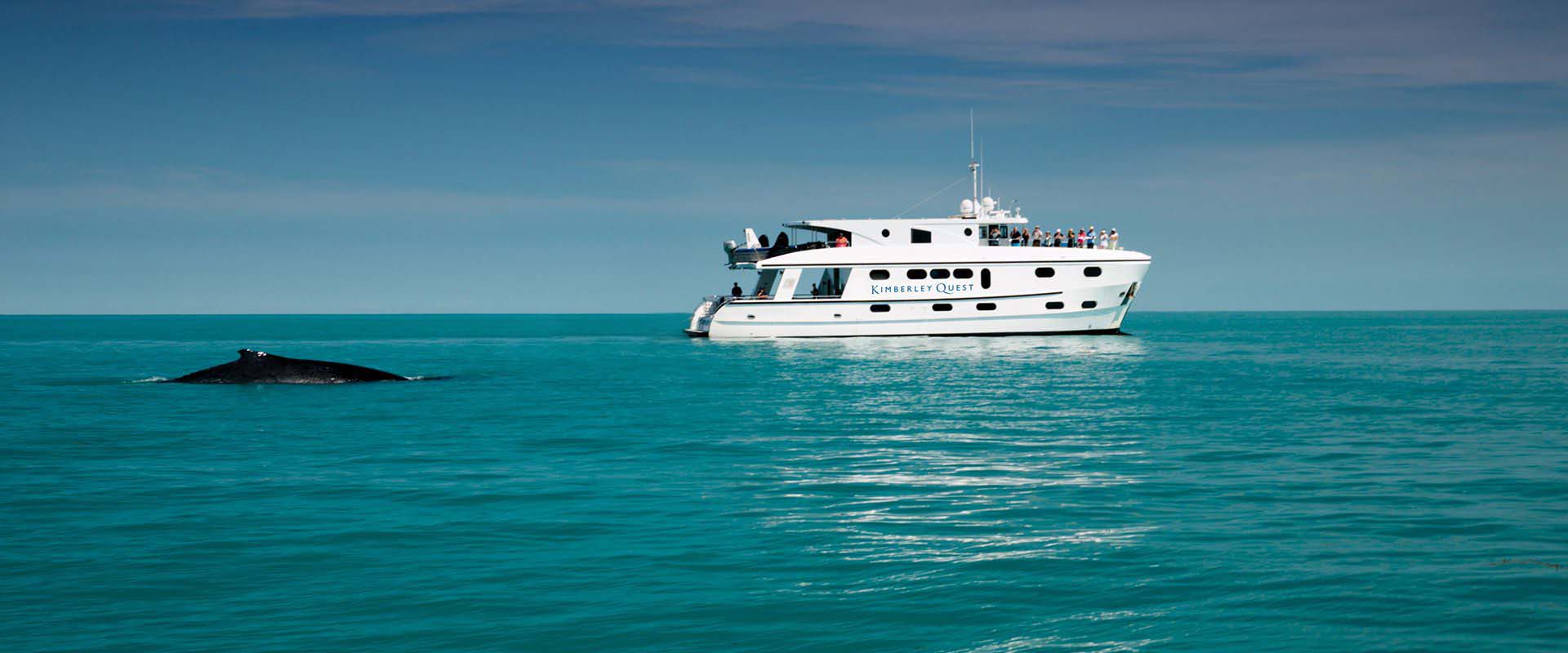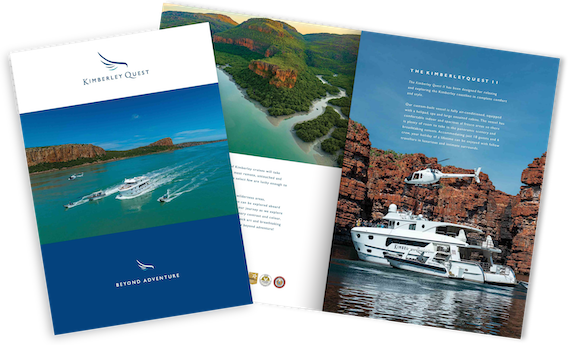An inexhaustible land of dreams
Ancient rock art, falls and rivers prove age hasn’t wearied the Kimberley, John Borthwick writes.
IT’S A WORLD of red rocks and big crocs, of pearls and ancient art – and catching a few barra before breakfast. “I thought I’d better see this place before I ran out of time,” quips Colin, a 70-ish Queenslander, as our vessel, Kimberley Quest II, pulls out of Wyndham.
With a bonfire sunset above us we turn south. Ahead lie two weeks and 900 kilometres of adventures along a coastline “steeped in history and older than imagination”. It’s a realm beyond phone, fax and email.
Morning finds us cruising up the Berkeley River between silent escarpments of red sandstone. While the rocks are about 1800 million years old, the name, Berkeley, is a mere 95 years young. So recent is European exploration of the Kimberley waters that many parts of our map still say “unsurveyed”.
We – 14 passengers, six crew and two naturalists – climb into KQII’s four aluminium dinghies and head for shore. Rock wallabies scamper at the sight of us. We trek past ghostly boabs and Aboriginal shell middens to reach a waterfall sufficiently high above the tidal river that no saltwater crocodiles can reach where we swim.
Brahminy kites and black cockatoos flit through the deep azure sky causing the half-dozen twitchers (serious birdwatchers) among us to leap for their binoculars. Back on board the chef, Ona, has prepared the first of her fabulous soups. We eat, snooze, read and cruise past a shoreline whose eroded pillars could be those of a tumbled, sandstone Camelot.
“This far north-west coast, split into a thousand fjords breathtaking in their colour and beauty, is far and away the loveliest in Australia,” wrote 1930s traveller and author Ernestine Hill. She predicted correctly that one day the Kimberley would be a world-famous tourist attraction.
Dramatically, we see what she meant when we anchor the next night just metres from the roaring, 80-metre high cataract of King George Falls – the tallest in Western Australia. It is the finale to a day that has included a 5.30am fishing trip (or for the birders, a shore walk) and an excursion to Pangali Cove in Koolama Bay, site of a World War II attack on a passenger ship by Japanese bombers.
Our guide, Tim Willing, explains how the MV Koolama safely beached in this cove, with many passengers trekking overland for days to a missionary station. We’ve also seen rock art, crocodile tracks and ancient Macassan fishing camps – all part of an “ordinary” day in the extraordinary Kimberley.
Waking the next morning to the roar of King George Falls, we climb to the top for a breathtaking vista of the cascade, plus a swim in a cool upper pool. Skipper Neil Harding next takes us to the Kimberley’s longest river, the Drysdale. Such is the proliferation of whistlers, warblers, kites, sea eagles and egrets that our birders and their ardent guide, George Swann, seem to be talking in feathers.
Meanwhile the botany lovers, naming every tree and flower, are speaking in Latin. I make do with calling saltwater crocodiles “salties” and dolphins and flying foxes just that.
The goony bird is nowhere on our birdwatchers’ list but we find an excellent specimen resting on a mudflat beside Vansittart Bay. The US Army DC3 aeroplane, also known as a Dakota or, confusingly, gooney bird, crash-landed here in 1942 when it ran out of fuel en route to Broome. We trek through the bush to examine its remarkably intact fuselage.
At Vansittart Bay we also have our first close look at the enigmatic “Bradshaw” or Gwion Gwion art found along this coast. These delicate ochre figures dance before us across a rock face and across time – some 17,000 years at least – arrayed with dilly bags, weapons and headdresses.
Entirely unlike Aboriginal Wandjina images, the Bradshaw figures were done by rainforest dwellers arriving from South-East Asia, it is speculated. The paintings are named after local pastoralist Joseph Bradshaw, the first European to record them, in 1892.
“No fish and a wet bum,” reports Colin after an unsuccessful fishing excursion. The next day he does better with two sizeable trevally but still reports “more march fly bites than fish bites”. Despite the luxuries we have aboard our 25-metre vessel – air-conditioned cabins with en suite bathrooms, lounge, library and Ona’s gourmet meals – I remind myself of how harsh the Kimberley really is.
In an area larger than Japan, the 421,000-square-kilometre Kimberley has only 35,000 residents, most of whom live in a handful of settlements. The Kimberley hides bays and sounds so vast that you could pour Sydney Harbour into any of them and hardly notice the ripples. The only signs of modern humanity I see in a week are a light plane, a navigation beacon tower, a pearl farm and another cruise boat.
Coming ashore on an empty beach framed by the primal beauty of a teal lagoon, ochre cliffs and a bridal veil waterfall, I imagine that anywhere else in the world, these sands would probably bristle with deckchairs and the Cataract Hilton would overlook the falls. So, why not here? The answer lies in the “crocodile slides” – ominous tracks that cross the sands from lagoon to beach.
“Don’t stand near the shoreline and don’t fish from low rocks by the river,” warns crew member Sammy. The crew is hyper-cautious, always mindful of the fatalities that have happened, albeit rarely, up here. The most publicised was the death of an American yacht hand taken by a croc at King Cascade in 1987.
“If the skeeters don’t get you then the gators will.” These words of warning from an old Kingston Trio song come to mind as we scoot past the mangrove alleys and sandstone valleys of Mitchell River in our tinnies, heading for a swim in Surveyors Creek.
Afterwards, I lie back on the warm rocks, drying, adrift somewhere between streamtime and dreamtime. My reverie is broken by the twitchers spotting a rare chestnut rail, though they’re never satisfied. The next must-see for their check lists is an equally rare black grass wren.
The Kimberley has an erratic history of European exploration and settlement. At a spot called Careening Bay we motor ashore to find a huge double-trunked boab first visited in 1820 by Phillip Parker King during a survey of the coast. He careened his vessel HMC Mermaid here and carved its still-visible name into the boab that is now known as the Mermaid Tree.
We continue south to St George Basin, the Kimberley’s largest inland sea. Cruising up the straight fault line of the Prince Regent River, we reach the King Cascade, with its wedding-cake tiered waterfalls and grim history. It was here in 1987 that Ginger Faye Meadows, who had swum from her dinghy to the falls, was taken by a crocodile.
The Kimberley seems inexhaustible in its vistas and wonders. Towards the end of our voyage, we head offshore. Twenty kilometres out to sea we find the phenomenon of Montgomery Reef, a 300-square-kilometre coral platform that, as low tide drains off it, rises some eight metres out of the sea. In the dinghies we navigate upstream through a channel in the reef and watch as turtles, fish, mantas and sharks swim through this roaring, draining “river” in the middle of the ocean.
Then it’s more caves of luminous ancient art. Oyster gathering forays on nameless shores. Swimming at secret waterfalls in the bush. We weave through the Buccaneer Archipelago (named after privateer William Dampier who explored here in 1688) to reach our last great spectacle, Talbot Bay’s magnificent Horizontal Waterfalls.
Here, a massive 10-metre tidal fall sucks huge volumes of ebbing water through a narrow chasm between the cliffs. Today the “step” in the falls is too steep for our boatmen even to attempt to run through it. Instead, we watch in awe.
Overnight the KQII will head down to Broome, our final port. Our home run starts at Cape Leveque with a last flaming sunset. And the skipper’s mobile phone ringing. After two newsless weeks in Kimberley dreamtime, we are suddenly back in range of phone towers, superpowers and 21st century machine time.
The writer travelled courtesy of Kimberley Quest.
TRIP NOTES
Kimberley Quest II has itineraries of seven, eight and 14 days departing from Wyndham and Broome between March and October. Prices begin at $6340.
Getting there: Qantas flies to Broome and Wyndham.
Accommodation: Cable Beach Club Resort, Broome. See www.cablebeachclub.com.
This article was originally published in the Sydney Morning Herald. See: https://www.smh.com.au/lifestyle/an-inexhaustible-land-of-dreams-20060528-gdnmm5.html


